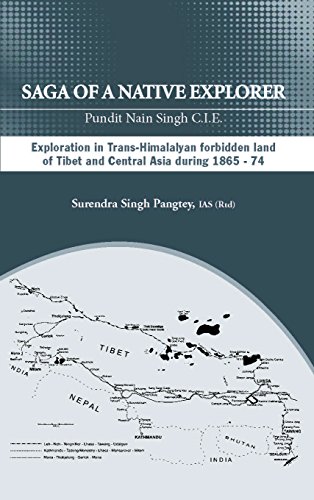nain singh pundit (1 resultados)
Tipo de artículo
- Todo tipo de artículos
- Libros (1)
- Revistas y publicaciones
- Cómics
- Partituras
- Arte, grabados y pósters
- Fotografías
- Mapas
-
Manuscritos y
coleccionismo de papel
Condición
- Todo
- Nuevos
- Antiguos o usados
Encuadernación
- Todo
- Tapa dura
- Tapa blanda
Más atributos
- Primera edición
- Firmado
- Sobrecubierta
- Con imágenes del vendedor
- Sin impresión bajo demanda
Ubicación del vendedor
Valoración de los vendedores
-
Saga of a Native Explorer
Publicado por Bishen Singh Mahendra Pal Singh, 2017
ISBN 10: 8121109604ISBN 13: 9788121109604
Librería: Vedams eBooks (P) Ltd, New Delhi, India
Libro
Soft cover. Condición: New. Contents: I. Diary One-First Lhasa Journey (20 March 1865): 1. Genealogy of Nain Singhs Clan. 2. Laddakh expedition, Nain Singh becomes teacher and failure of first attempt to enter Tibet. 3. Nain Singh and Mani decide to proceed to Lhasa separately-Ex Garpon of Gartok, garpon of Kirong known to Mani. 4. Nain Singh awaiting at Tadong monastery for arrival of Laddakh traders. 5. The tradition of incarnation of Gyewa Rimpoche of Lhasa (Dalai Lama). II. Thok Jalung Diary 1867 (25 July, 1867): 1. Expedition to gold mines of Thok Jalung. 2. Nain Singh at Thok Jalung. 3. Return journey from Thok Jalung. III. Nain Singh with British, Yarkand Mission Diary three-Yarkand-Khotan (1873-74): 1. Initial order for Nain Singh for survey of Darjeeling to Lhasa altered for joining Yarkand Mission. 2. Arrival of Yarkand Mission at Leh. 3. Nain Singh on his own in Karghalik-Posgam region: no help from Yarkand Mission. 4. Nain Singh at Yarkand town-taxation system, local customs and traditions and trade and transaction rules. 5. The land of mines, idol worshippers and rich urban settlements. 6. Nain Singh ordered to survey Leh and Pare Chu. 7. Nain Singh hit by violent blizzard, cold blooded murder of Adolf Schlagintweit by cruel Wali Ali Anjani. Tibet and Central Asia attracted adventurists from Europe for its spiritual secrets and hitherto unexplored mineral wealth. Apprehensive of adverse impact on their spiritual way of life, entry of foreigners in Tibet was closed by its authorities since 18th century. Many Europeans failed in their attempts of reconnaissance of forbidden land clandestinely because of their distinct physical features. British survey officer T.G. Montgomerie innovate the idea of using trained native explorers, in disguise as traders. Montegomerie selected two cousins in 1863. Mani Singh and Nain Singh, from border village of Milam of district of Pithoragarh for this purpose. Both were part of Laddakh expedition of 1856-1857 undertaken by Schlagintweit brothers (Adolphe, Herman and Robert) under the patronage of Prushia Monarch Fredrik Williums IV, supported by Directors of Court of East India Company. During this expedition they learnt the techniques of trignometical survey. They were trained in methods of clandestine survey at Dehradun during 1863-64. Out of the two Nain Singh successfully entered Tibet and brought back valuable trignometrical data and socio-political information of hitherto unknown region. Besides his trip with Schlagintweit brothers and Yarkand mission, he crisis-crossed Tibet three times at great risk to life. He ventured into areas heavily infested by robbers and dacoits like Kirghiz Jungal or Changthang of northern Tibet. He had to pass certain nights without food and drinking water. He fell ill or was over fatigued on many occasions and at times he had close encounter with death. But he did not deter from his objective of route survey including tiresome monotonous job of counting paces in all kinds of terrain, and clandestinely taking stellar observations and the boiling points of water with precision. He recorded details of socio-political conditions of forbidden land of Tibet and Central Asia. He left valuable accounts of his expeditions in the form of diaries and journals, many of which have been printed by various groups. However his narratives are in Hindustani in Deonagri script, not easily comprehensible to modern readers. He used words from Urdu, Farsi and other oriental languages, which were in prevalence during his time.


